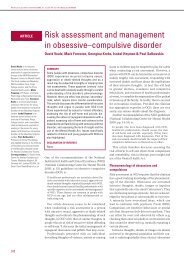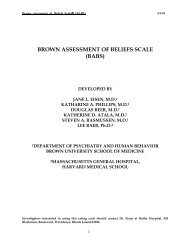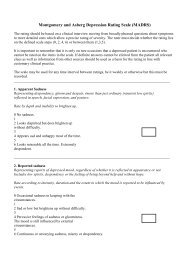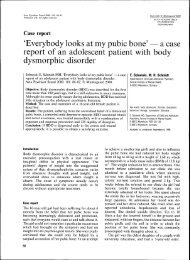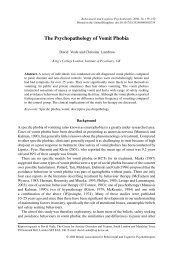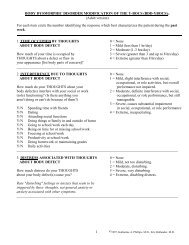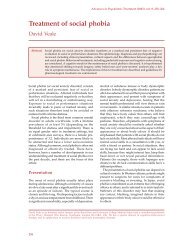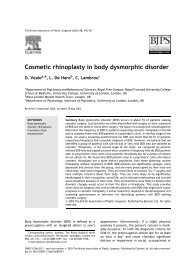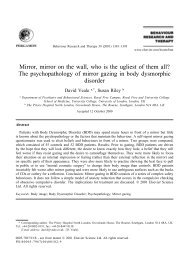Cognitive behaviour therapy for a specific phobia of vomiting
Cognitive behaviour therapy for a specific phobia of vomiting
Cognitive behaviour therapy for a specific phobia of vomiting
You also want an ePaper? Increase the reach of your titles
YUMPU automatically turns print PDFs into web optimized ePapers that Google loves.
280 D. VealePeople with SPOV may believe that if <strong>vomiting</strong> were to occur it would last <strong>for</strong> many days.Here the therapist can provide normative in<strong>for</strong>mation on how long <strong>vomiting</strong> normally lasts <strong>for</strong>after an infection or food poisoning, this might be assisted by a survey <strong>of</strong> others about howlong <strong>vomiting</strong> persisted when they were ill.Others believe that they can influence or control their <strong>vomiting</strong>. However, the act <strong>of</strong> <strong>vomiting</strong>is a primitive reflex act that cannot be inhibited. People with SPOV tend to focus on the risk <strong>of</strong>infection or food poisoning but the reflex can be triggered by a wide variety <strong>of</strong> stimuli aroundthe body (e.g. mechanically in gynaecological problems, a stretched gall-bladder or stomachor by certain drugs or metabolic problems that act on the brainstem, extreme fear, severe pain,certain smells). If a vomit reflex is triggered then it cannot be ‘controlled’. This is difficult todemonstrate in a <strong>behaviour</strong>al experiment despite the above in<strong>for</strong>mation.Therapy begins with a developmental <strong>for</strong>mulation. If there are early adverse experiences<strong>of</strong> <strong>vomiting</strong> they can be linked to current problems and discussed as ‘ghosts <strong>of</strong> the past’ thathave not yet been updated. It is also worth the therapist emphasizing that developing a SPOVis highly understandable given the way that humans and animals can easily become averseto certain foods after, e.g. food poisoning or an infection, and avoid situations that remindthem <strong>of</strong> <strong>vomiting</strong>. Validate the fact that <strong>vomiting</strong> in childhood can be very panic inducing(e.g. the association with the feeling <strong>of</strong> suffocation, choking or death). Explain that as anadult you know these associations are not true, although they remain powerfully linked inthe mind. However, there are reasons to be optimistic because even things learned over manyyears can be ‘unlearned’ and many people with SPOV can overcome their problem or make itmore manageable. Note that not everyone will be able to recall early adverse experiences <strong>of</strong><strong>vomiting</strong> as they may no longer be accessible.A client with SPOV is <strong>of</strong>ten reluctant to engage in any treatment that involves exposure toany risk <strong>of</strong> <strong>vomiting</strong>. She may have marked health anxiety and believe that she is especiallyvulnerable to <strong>vomiting</strong> or at a higher risk <strong>of</strong> <strong>vomiting</strong> compared to others. She may havereceived a diagnosis <strong>of</strong> irritable bowel syndrome or an allergy as an explanation <strong>for</strong> nauseaand other gastrointestinal symptoms. Engagement may be assisted following the model <strong>of</strong>hypochondriasis (Clark et al. 1998), where a client is presented with two alternative hypothesesto test out in <strong>therapy</strong>. ‘Theory A’ (the one she has been following) is, <strong>for</strong> example, that she ismore prone to <strong>vomiting</strong> and that she has an increased ability to control her <strong>vomiting</strong>. ‘TheoryB’ is that the problem is <strong>of</strong> worrying excessively about <strong>vomiting</strong> and trying too hard to preventherself from <strong>vomiting</strong> (<strong>for</strong> which the unintended consequences are her feeling that she is morevulnerable to <strong>vomiting</strong>; feeling more nausea from anxiety, or feeling she has control over her<strong>vomiting</strong>.)The therapist might discuss metaphors about solutions (e.g. man in the hole; Hayes et al.1999). The emphasis in engagement is focusing on the how symptoms <strong>of</strong> nausea, the handicapand distress are maintained by avoidance, safety-seeking <strong>behaviour</strong>s and excessive vigilance.Thus the goals in <strong>therapy</strong> <strong>for</strong> the client are to become functional and follow their importantdirections in life, as trying not to vomit has a significant cost and, as yet, no or little effect onthe frequency <strong>of</strong> <strong>vomiting</strong>.Maintenance modelProgress can be made to an understanding <strong>of</strong> the current processes that maintain the client’sfear by drawing an idiosyncratic model (Fig. 1). Central to the model is the way a personwith SPOV may (a) re-experience past memories <strong>of</strong> vomit or <strong>vomiting</strong> and fuse them



